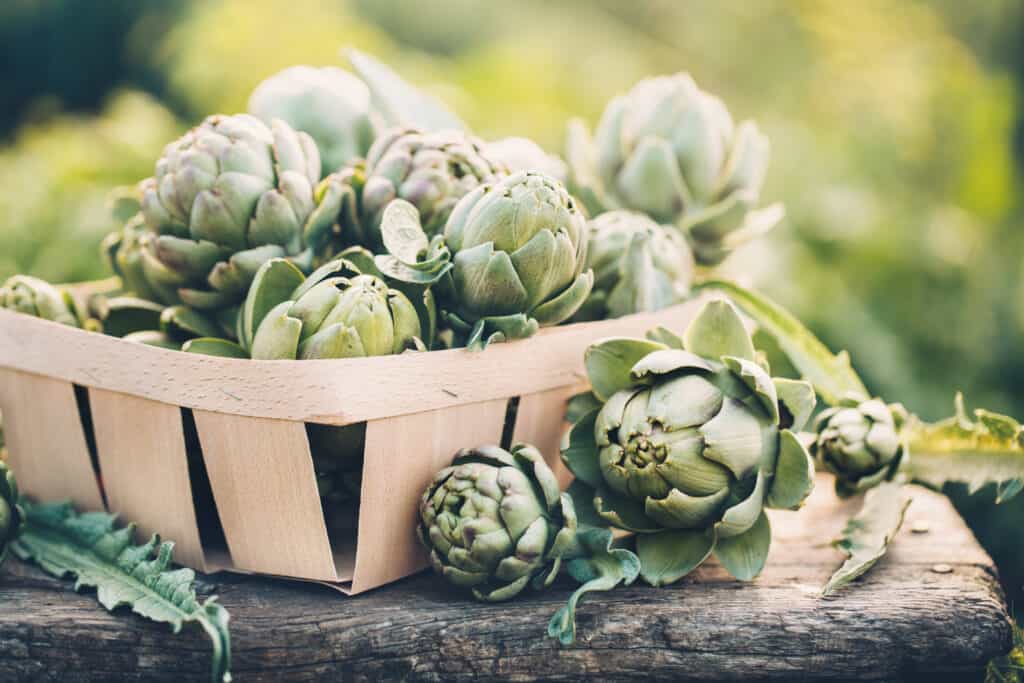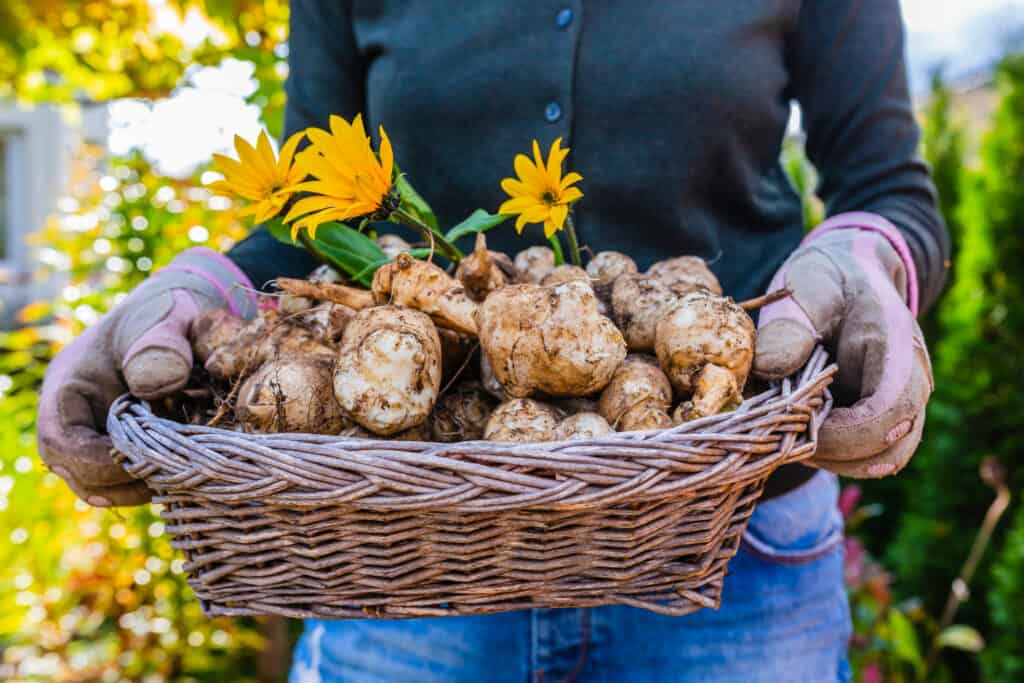Artichokes are delicious plants that are packed full of fiber and nutrients. You may have tasted them in pasta dishes and dips. However, there is some confusion over artichokes and Jerusalem artichokes. Is there any difference and aren’t Jerusalem artichokes just artichokes from Jerusalem? Let’s look a little closer and see what holds these two very different plants apart. Ring the starter bell, it’s time for Jerusalem artichoke vs artichoke.

Artichokes are perennial plants that originated in the Mediterranean. They are interesting looking and enjoyed in myriad dishes.
©Valentina_G/Shutterstock.com
| Jerusalem Artichoke | Artichoke | |
|---|---|---|
| Name | Helianthus tuberosus | Cynara cardunculus var. scolymus |
| Origins | North America | Mediterranean |
| Perennial or Annual | Perennial | Perennial |
| Flowers | Yellow sunflowers | Purple thistle-like |
| Foliage | Rough, hairy ovals | Grey green, deeply divided |
| Hardiness | Zone 4 and above | Zone 7 and above |
| Toxicity | Not toxic | Not toxic |
What is an Artichoke?
Artichokes (Cynara cardunculus var. scolymus) are part of the thistle family and are also known as globe artichokes, French artichokes, or green artichokes. They’re a species of thistle used for food. The globe artichoke is considered the true artichoke and you only eat the tender leaves and head of the bud before it blooms.
This is very different from Jerusalem artichokes!
What is a Jerusalem Artichoke?
The name is deceiving because a Jerusalem artichoke (Helianthus tuberosus) is not an artichoke at all; it’s actually a type of sunflower. We eat the lumpy brown tuber root, not the buds and leaves. But that’s not all — the Jerusalem ‘artichoke’ doesn’t have anything to do with Jerusalem either! It’s a form of the Italian word for sunflower ‘girasole’.
Jerusalem artichokes are also known as sunchokes and earth potatoes.
Jerusalem Artichoke vs. Artichoke: Origins
True artichokes are native to the Mediterranean area. They’re a form of domesticated wild cardoon (Cynara cardunculus). Their historical role as food is up for debate. Some scholars support the idea they were eaten by the ancient Greeks, but others believe the ancient Greeks ate wild cardoons and the domesticated artichoke developed much later.
Its name is also a mystery. It seems to be a form of the Italian arci for chief and ciocco for stump!
The world grew 1.5 million tons of artichokes in 2020 with California producing nearly all artichokes for the US market, particularly Castroville which holds an artichoke festival each year.
In contrast, Jerusalem artichoke, also known as sunchoke, wild sunflower, and earth apple, is a sunflower species native to North America. Native Americans ate the tubers and when early Europeans colonized the Americas they sent tubers back to Europe where they successfully grew. They are especially popular in French soup!
As we’ve seen, its name is most likely Italian girasole for sunflower, but an alternative explanation is that the Puritans named the plant ‘Jerusalem’ as they relied on it for food as they created a new Jerusalem in the wild west.

Jerusalem artichokes, also known as sunchokes, are actually sunflowers that are native to North America. Their tubers are edible and popular in French soups.
©iMarzi/Shutterstock.com
Jerusalem Artichoke vs. Artichoke: Leaves
Artichokes can reach several feet tall and their leaves are long, grey-green, and very divided. Their leaves cover the stem leading up to the edible bud where thick tender leaves protect the heart. These leaves are small, fleshy and tasty too!
Jerusalem artichokes reach up to ten feet tall and have mid-green rough and hairy oval leaves that gradually get smaller in size as they climb the stem. Jerusalem artichoke tubers are usually 4 inches long and 2 inches wide. They look a lot like ginger roots and are creamy white in the centre. Artichokes don’t have tubers; they have roots instead.
Jerusalem Artichoke vs. Artichoke: Flowers
You don’t often get to see an artichoke flower because the ‘heart’ we love to eat is actually the bud that hasn’t flowered yet, but if you’ve spotted a cardoon it’s much the same with hundreds of slim purple petals reaching upwards to form a thistle-like crown.
Artichokes flower in May and bees adore them, sometimes consuming so much rich artichoke nectar they appear drunk.
Jerusalem artichoke flowers are very different. They are small sunflowers measuring four inches across with up to 20 yellow petals and a chocolate brown disc in the center.
Jerusalem artichoke flowers are vanilla scented and irresistible to bees and butterflies too. They flower in October so if you have a wildlife-friendly garden there’s no need for Jerusalem artichoke vs artichoke, you can grow both and feed bees from May to November.
Artichoke Growing Zones
Artichokes are perennial, but they are sun lovers so do best in growing zones 7-11. Below this and you’ll probably need to grow them as annuals because they aren’t tolerant of frost and consistently low temperatures – they are a Mediterranean plant after all!
Jerusalem artichokes are much hardier and will grow in zone 4 and up. They are not frost tender so they’re are grown in a much wider range of habitats across the world.
Artichoke vs. Jerusalem Artichoke: How To Cook
Globe artichokes are not eaten whole. The tender outer leaves and the heart (the ‘choke’) are the best pieces. Eating its heart sounds gruesome, but it’s just the unflowered bud! Artichokes are best gently steamed, simmered, or eaten with vinaigrette and they make excellent dips, soup, and stuffing.
In Vietnam artichoke tea is popular and modern research indicates artichokes may be good for bowel and digestive problems. You can read about the medical uses of artichokes in this article.
In comparison, Jerusalem artichokes are prepared and cooked like potatoes and other root vegetables. They are best roasted, boiled, mashed, sauteed – basically anything you can do with a potato you can do with Jerusalem artichokes.
However, when it comes to Jerusalem artichoke vs artichoke in the taste department it’s a draw! Both are tasty, healthy plants packed with fiber and vitamins. Jerusalem artichoke is more filling, but some say globe artichokes have a more unusual taste. The choice is yours!
Jerusalem Artichoke vs. Artichoke: Safe For Pets?
Both Jerusalem artichokes and artichokes are not toxic and safe for pets to eat and be around, but it’s never a good idea to let your pets chew on garden plants. If you want to safely include supplements in your pet’s diet, choose a vet-approved supplement.
Jerusalem Artichoke Is A Root Vegetable
So we’ve discovered that Jerusalem artichokes and artichokes don’t have much in common other than a name.
Jerusalem artichokes are a sunflower species with yellow flowers and edible tubers whereas artichokes are thistles with edible leaves and flower buds.
Up Next:
The photo featured at the top of this post is © beats1/Shutterstock.com
Sources
- Springer, Available here: https://link.springer.com/article/10.1007/s11130-015-0503-8
- Plants for a Future, Available here: https://pfaf.org/user/Plant.aspx?LatinName=Helianthus+tuberosus
Thank you for reading! Have some feedback for us? Contact the AZ Animals editorial team.







